 |
SOHO or SMB NAS devices have become quite popular these days, with their rich feature set, low cost, and ease of adding large amounts of storage to your network. There are many companies that vie in this market segment, such as QNAP, Synology, LaCie, Infortrend, as well as Thecus. With Thecus specifically, they have been releasing NAS devices since they were established in 2004. Since that time, their product portfolio has grown to include options for just about any configuration. Also with every product iteration, they continue to improve and expand on the previous generation. All of this has led to Thecus being widely known and one of the more popular choices when it comes to NAS devices.
While Thecus offers products for large business to home use, today we will be taking a look at the N5550, which is targeted for SMB (Small/Medium Business). In the Tower (as opposed to rackmount) SMB product category, Thecus has NAS devices with 2 to 7 drive bay configurations, and these units will also differ in CPU speed and pre-installed memory. Also, since this is targeted for the SMB market, the N5550 has features such as iSCSI Thin-Provisioning, RSync Backup, and User quotas.
Before getting to the review, let’s take a peek at the Thecus N5550 hardware specifications:
- Intel Atom Dual-Core 1.86GHz CPU
- 2GB DDR3 RAM
- 5 x 3.5” SATA hard disk drive bays
- LAN ports:
- 2 x 10/100/1000 BASE-TX Auto MDI/MDI-X
- USB ports:
- 1 x USB 3.0; 4 x USB 2.0
- 1 x eSATA port
- 1 x HDMI port
- 1 x VGA port
- Audio: 1 x MIC input, 1 x Line input, 1 x Audio output
- LCD panel
- Dimensions: 230 x 190 x 240 (mm)/ 9.06 x7.48 x 9.45 (in)
- Weight: 4.38(Kgs)/9.66(lb)(NAS only)
- 200W AC power supply
- System fan: 1 x SmartFan
With the hardware specifications, I was immediately surprised to see that Thecus went with a lower clock Atom process, in comparison to other 5-bay offerings from other vendors. It will be interesting to see if this has any impact on performance. Also, with the prevalence of USB 3.0 devices these days, it would have been nice to have more than a single USB 3.0 port on the N5550. The availability of an HDMI, VGA, and Audio ports, this is not something we see on some competing offerings from other vendors, especially products offerings targeting the SMB market. Having the ability to directly attached a monitor, keyboard, and mouse is a nice option.
Unboxed:
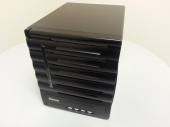 |
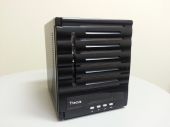 |
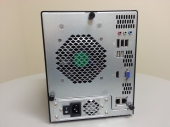 |
Unboxing the Thecus N5550, the packing is quite sturdy and does a great job of ensuring that the N5550 should arrive to you damage free (baring any extreme shipping conditions). With everything unpacked, here are the contents:
- 1 x Thecus N5550 NAS unit
- 5 x Drive Carriers
- 1 x Power Cable
- 2 x Cat 5e Ethernet Cables
- 1 x Installation CD
- 1 x Arconis True Image DVD
- 1 x Accessory Bag (Screws and Key)
- 1 x Quick Installation Guide
- 1 x Warranty Card
- 1 x HDD Compatibility Guide
For the most part, the included items are pretty standard fare for products in this category, however Arconis True Image and an HDD compatibility guide are welcome additions. Aside from that, you should have everything you need to get the Thecus n5550 up and running right out of the box.
 |
Initial Impressions:
With the Thecus N5550 out of the box, the overall design isn’t anything revolutionary as far as 5-bay NAS enclosures go. Everything, aside from the LCD panel, is hidden behind a vented door. The vented door had a fair amount of flex in it, that made it feel like it might easily break. This was only noted as the vented door is secured by a locking mechanism that requires you to push on the door to lock and unlock (similar to those pre-fab furniture cabinet doors). There is no lock on the vented door, but there are individual key locks on each drive bay. With the vented door open, the 5 drive bays, status LEDs, power/reset buttons, USB 3.0 port, and navigation buttons for the LCD panel are immediately accessible. The decision by Thecus to include a front panel LCD is a big bonus in my opinion, as it allows for quick status updates without having to log into the management interface.
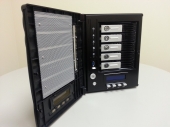 |
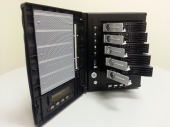 |
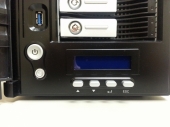 |
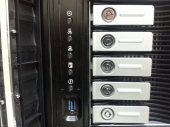 |
On the rear of the unit is where the remaining (and majority) of the connectivity ports are located. Here you have 1 x AC port, 4 x USB 2.0, 2 x 1Gb Ethernet, 1 x eSATA, 1 x VGA port, 1 x HDMI port, and audio ports. As already noted, it would have been nice to have more USB 3.0 ports on the rear of the unit.
 |
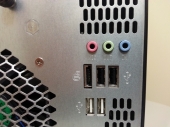 |
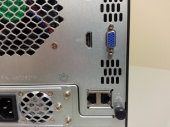 |
Taking a look at the driver carriers, Thecus chose metal carriers and didn’t cheap out here using all plastic carriers. The locking mechanism is also another area where some cost cutting can occur, but the locking mechanism on these carriers appear to be very robust and will hold up over time.
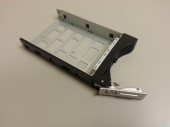 |
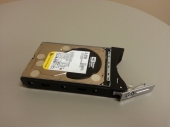 |
Thecus makes servicing and upgrading the N5550 very easy. After a couple thumb screws, the entire external chassis cover lifts off and exposes the internal components. Adding additional memory is very easy endeavor. Aside from the single enclosure fan, everything appears to be passively cooled. Assuming the single chassis fan is capable of drawing enough air to cool 5 drives and the mainboard vital components, the omission of additional fans will help keep the audible noise to a minimum.
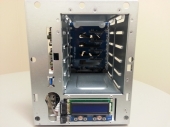 |
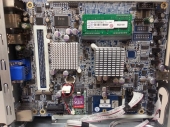 |
 |
Software features:
| RAID |
|
| Disk |
|
| Network |
|
| System Status |
|
| Data Access |
|
| Data Backup |
|
| Block Level Access |
|
| Power Management |
|
| Volume Management |
|
| Multimedia Support |
|
| User Authentication |
|
| Cloud Backup |
|
| File System |
|
| Administration |
|
| Mobile Applications (iOS/Android) |
|
| Data Security |
|
| Capacity Expansion |
|
| Others |
|
Looking at the long list of features that the Thecus N5550 supports, many of the SMB centric feature items are checked. These include iSCSI, multiple RAID level support, RAID migration and expansion, Disk hot swap and hot spare, User/Group ACL, backup and recovery, wide range of protocol support, and system monitoring. There are also alot of features that are not necessarily SMB centric, such as photo/video/streaming support, IP camera, and mobile device support. the Thecus N5550 has an impressive feature list, which should cover just about anyone looking for a fully capable NAS in this product/price range.
 |
Setup and Configuration:
Now that the Thecus N5550 is unboxed and cabled up, it is time to power it on and get it configured on the network. Using the included CD that contains a setup wizard, once the N5550 is fully booted (which can be confirmed visually looking at the front LCD panel), the setup wizard will automatically discover the N5550. Once discovered, the wizard will step you through a small set of steps to get the N5550 configured on your particular network. Once you have completed the steps in the setup wizard, you should be able to open a browser and using the IP you configured, you should be able to connect to the web user interface for the N5550. Using the password you configured during the setup wizard, you can then log into the N5550 and from here you have full access to all the various configuration, settings, and information required to deploy and manage the N5550.
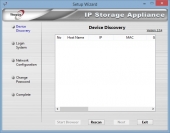 |
 |
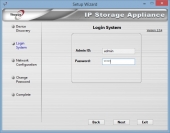 |
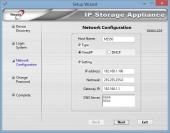 |
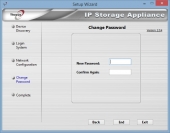 |
 |
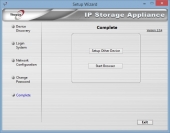 |
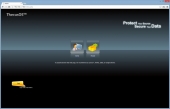 |
Below are screenshots from each menu within the web user interface. I won’t go through each one of these screens independently, but these will give you a preview as to what to expect and what can be configured on the N5550. I will say that in the web user interface is extremely responsive and at no time did I feel it was a detriment to the overall product representation or quality. It’s laid out in an intuitive manner and provides a wealth of management functions for an SMB class product.
Main Screen:
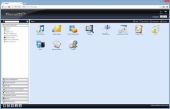 |
System Information:
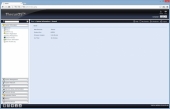 |
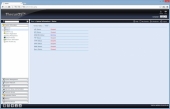 |
 |
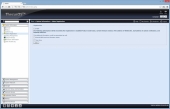 |
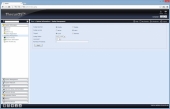 |
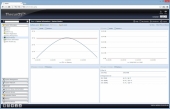 |
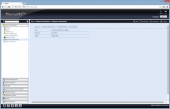 |
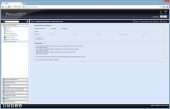 |
System Management:
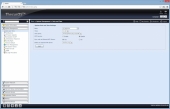 |
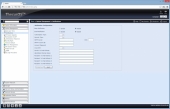 |
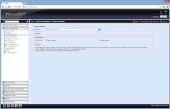 |
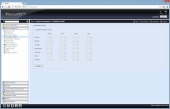 |
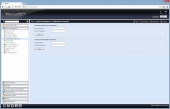 |
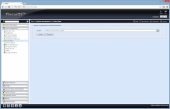 |
 |
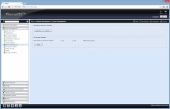 |
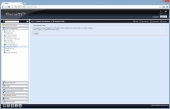 |
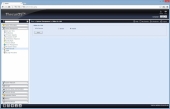 |
 |
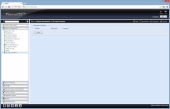 |
System Network:
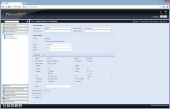 |
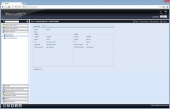 |
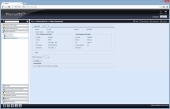 |
Storage:
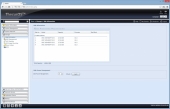 |
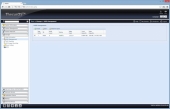 |
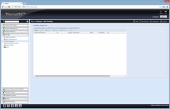 |
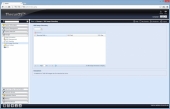 |
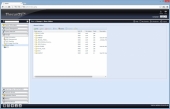 |
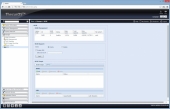 |
User and Group Authentication:
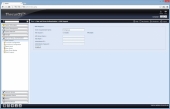 |
 |
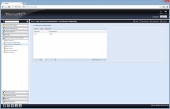 |
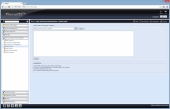 |
 |
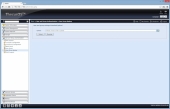 |
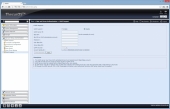 |
Network Service:
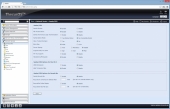 |
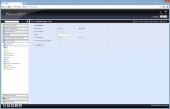 |
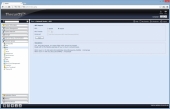 |
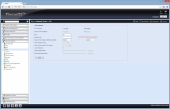 |
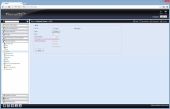 |
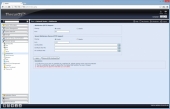 |
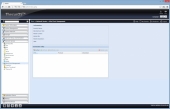 |
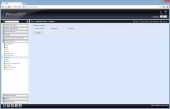 |
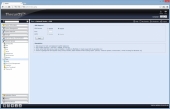 |
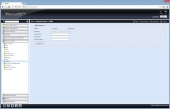 |
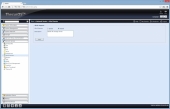 |
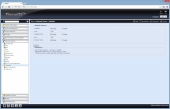 |
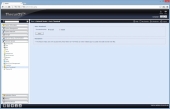 |
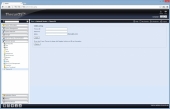 |
Application Server:
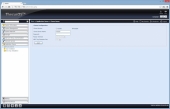 |
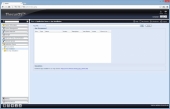 |
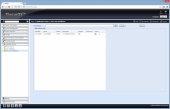 |
Backup:
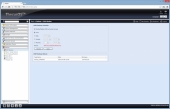 |
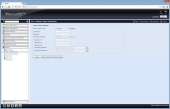 |
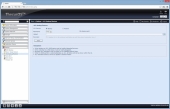 |
 |
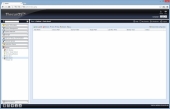 |
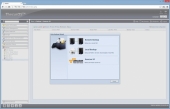 |
External Devices:
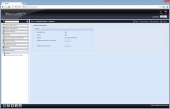 |
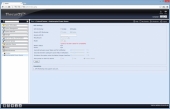 |
 |
Benchmarks:
CrystalDiskMark:
Although I never expect to go into this particular test expecting a 1Gb connected NAS device to perform the same as a direct attached RAW drive, it’s always good to get an idea of what the expected performance delta will be for the particular drives you intend to install into your NAS versus the advertised speeds of the drives if they were direct attached to a storage controller.
For this test, I ran CrystalDiskMark on a single RAW drive attached to a storage controller versus a single drive configured as an iSCSI target on the Thecus N5550. The results were good in that both the read and write performance of the drive configured as an iSCSI target were near identical. So the Thecus N5550 doesn’t appear to be tuned for writes or reads specifically. We have seen some NAS devices favor either reads or writes in the past, so it’s good to see that the Thecus treats read/write I/O fairly.
 |
File Transfer Tests:
For a basic file transfer test, I configured a share/pool that was comprised of four drives in a RAID 0, for maximum performance (multiple spindles, with no redundancy overhead placed on the CPU). I tested a single 3GB file and a single 1GB file, as I wanted to see the performance delta, if any, between a file larger and smaller than the amount of installed RAM. Based on my findings, the Thecus N5550 obviously leverages the installed RAM for writes (not that all uncommon), but what is interesting is that with only 2GB of RAM installed, the different file sizes didn’t seem to be as large of a variable as I would have expected.
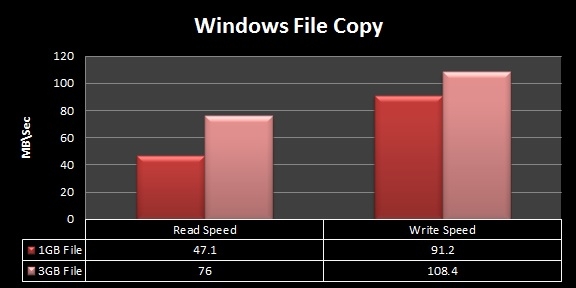 |
 |
Intel NAS Performance Test Toolkit:
This synthetic NAS benchmark network tool has been around for a while and thou no longer supported by Intel is still used today as a measuring stick for what a particular NAS device can do in pseudo real world situations. In this test, I limited the host system to 2GB using the advanced settings in msconfig to ensure that the test results were not skewed by large amounts of DRAM installed. Additionally, I chose to go a different way than other sites while performing these benchmarks, as I wasn’t just concerned about raw performance, but also dependability and performance when the unit was in a potential degraded state. All too often is the case that reviewers and consumers get too focused on what a particular unit can do in a “perfect” world, but neglect some of the “what if’s” life likes to hand us from time to time. I suspect anyone looking at a 4+ drive bay NAS device is not only purchasing it for performance, but also for redundancy (aka redundant RAID configurations) for added protection. Therefore, I decided not only would I run these benchmarks when everything was normal, but I also intentionally fail redundant RAID types and record the performance while the system was in a degraded state (missing a member) and while it was rebuilding. If you ever lose a drive, it is important to understand what changes to performance should be expected while your system is in a degraded state, as some applications and use cases are more performance sensitive than others. Also, it’s equally important to ensure that it handles these failures as gracefully as possible with no interruption in service. Since the Thecus N550 is targeted for SMB customers, I believe testing the device in this manner is not only prudent, but relevant. It is important to note, this testing methodology isn’t shared by many other review sites, so from a comparative standpoint, I would caution you from not making any knee jerk conclusions. Any device capable of RAID is going to have similar challenges and similar impacts to function and performance; these are not unique to Infortrend products.
HD Video Playback:
 |
2x HD Playback:
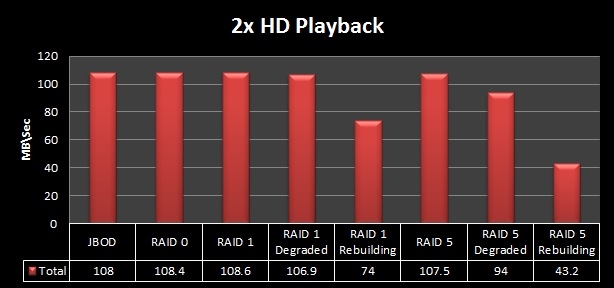 |
4x HD Playback:
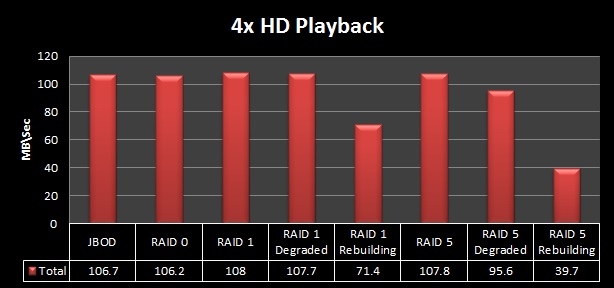 |
HD Video Record:
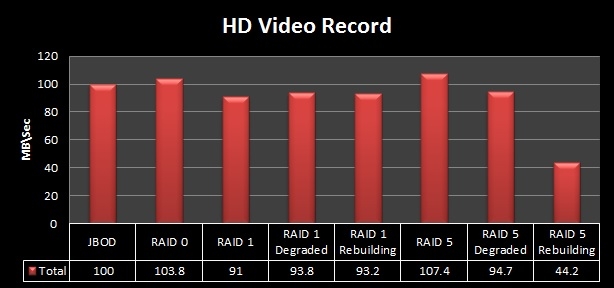 |
HD Playback and Record:
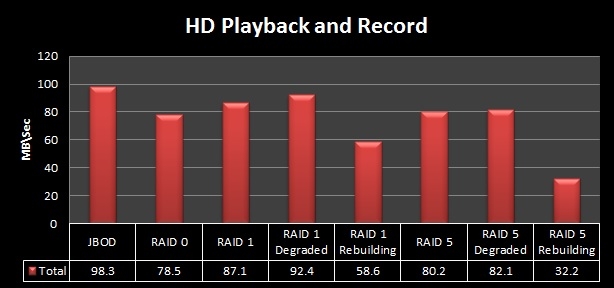 |
Content Creation:
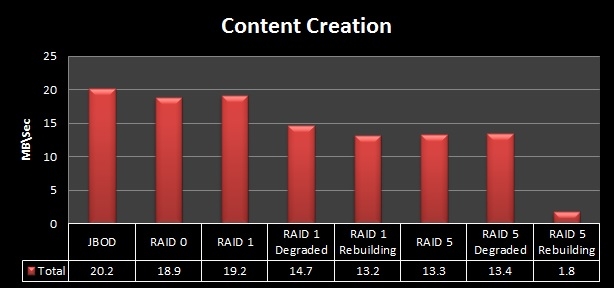 |
Office Productivity:
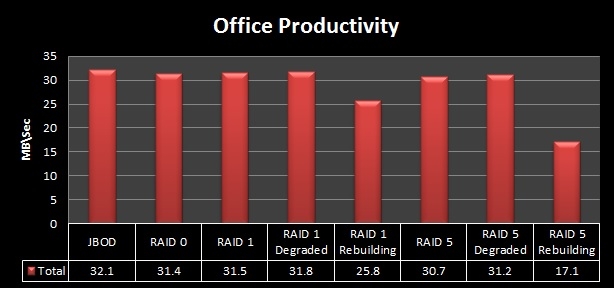 |
File Copy to NAS:
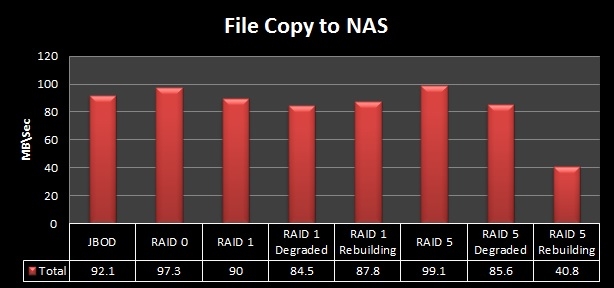 |
File Copy from NAS:
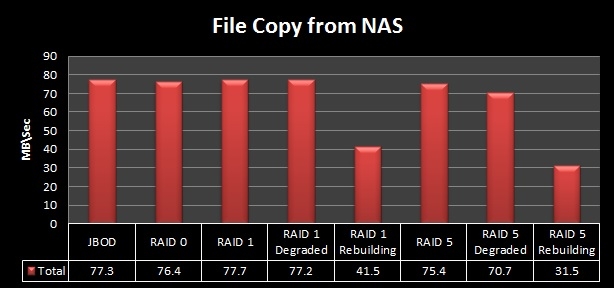 |
Directory Copy to NAS:
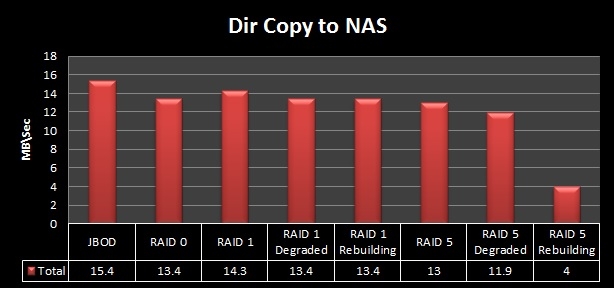 |
Directory Copy from NAS:
 |
Photo Album:
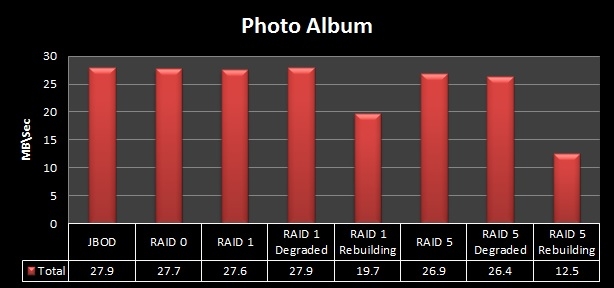 |
Looking at the results cumulatively, the Thecus was impressively consistent. By that, I mean, when configured storage was running in an optimal state, the performance was near identical across several storage configurations. It’s good to see that there were no oddities in performance in relation to the storage configuration. As to the performance numbers specifically, the Thecus is easily one of the higher performing NAS units we have tested here at Techwarelabs. The only area that the Thecus N5550 consistently showed a deficiency, was I/O occurring during a redundant RAID rebuild. This is to be expected to some degree as the CPU is not only serving I/O requests, but also rebuilding the RAID data concurrently. So where this is expected, across all the tests the performance drop was nearly 50% consistently with RAID 5 (where data is being rebuilt from parity data). Performance drop for a redundant RAID 1 wasn’t as consistent, but can be seen in some tests. This is something to be mindful of depending on how you wish to deploy the Thecus N5550 and what applications and use case scenarios you intend to run, as there may be an occasion where you will have to run while your redundant RAID is rebuilding and this may become a real factor. I will say that the Thecus had some of the slower rebuild times in comparison to some other NAS vendor products we have tested. With longer rebuild times, the measured lower performance while rebuilding will have a compound negative effect.
It’s also worth noting that during this testing, I failed multiple redundant RAID configs, and the Thecus N5550 handled the failures without issue and no interruption of I/O. Also, the rebuilding (although a little lengthy) occurred as expected and I could see the rebuilding progress percentage within the web UI.
 |
The Thecus N5550 has a market price of around $400 (give or take) depending on what online vendor you purchase it from. At this price, it falls on the lower end of the price spectrum from other 5-bay SMB NAS products from competing vendors. Generally, lower cost translates into lower performance, feature set, and quality. After spending time with the Thecus testing the unit, there are a few areas where I can see the lower cost being a factor (chassis quality, lower end Atom CPU, some missing features like no Data Deduplication), but these really end up being insignificant in the end. The Thecus N5550 is easily one of the fastest NAS devices in this segment we have tested here at Techwarelabs, which was unexpected given the lower end Intel Atom D2550 CPU it comes equipped with. This tells me that the folks over at Thecus have streamlined their NAS OS to a degree that they can leverage less horsepower (requiring less power and generating less heat) and deliver high end performance. I think this speaks to the maturity of their products, and dedication to delivering real value to their customers.
If you chose to skip to the end of this review to read the conclusion in hopes of skimming a single line to get the gist, well here it is. The Thecus N5550 will deliver well beyond it’s price tag, compared to other 5-Bay NAS devices from competing vendors, which is a welcomed and unfortunately rare trait for tech products these days.
Pro’s:
- Impressive high performance
- Responsive and functional web user interface
- High value, considering feature set and performance vs. product cost
- Reliability during unexpected drive failures
- HDMI, USB, and Audio ports allow for direct KVM access
Con’s:
- Single USB 3.0 port
- Longer then expected RAID rebuild times
- Performance halved during parity RAID rebuilds
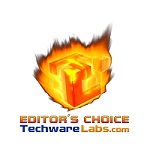 |

[…] Thecus NAS 5550 Server Review @ TechwareLabs […]
[…] Thecus NAS 5550 Server Review @ TechwareLabs […]
[…] Thecus NAS 5550 Server Review @ TechwareLabs […]
[…] Thecus NAS 5550 Server Review @ TechwareLabs […]
[…] Thecus NAS 5550 Server Review at TechwareLabs […]